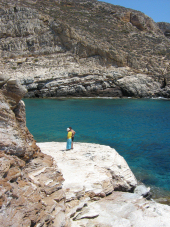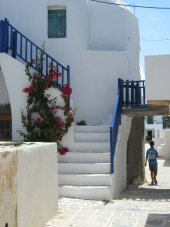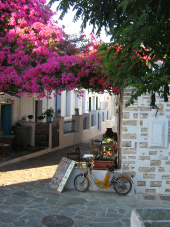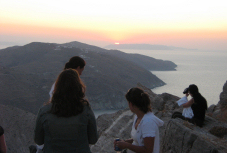By Susan Farewell
Click Here for Animated Map of Folegandros
Whenever I travel to Greece, it is with a great deal of baggage. And I don’t mean luggage. I am referring to the psychological load of expectations I have about this country.
I spent the better part of a year there as a student and have since returned several times, always eager to rediscover the Greece that stirred my thoughts and profoundly impacted my choices as a youth moving into young adulthood.
But so much of the Greece I knew has changed. Like many places around the world, it has become very global. Everyone speaks English (or seems to). You can’t tell the Greeks from the visitors. You can find many of the foods you get back home.
None of this is necessarily bad, but I can’t help wondering, where’s the Greekness?
 Truth is, the Greece I knew and loved is very much alive. But it’s not where most people are looking for it. To find it, you have to steer around the crowds. Go places the cruise ships don’t go, areas where air access is nonexistent or very limited, islands where ferry service may be intermittent. And…I can’t believe I’m saying it, but…places that don’t have major ruins. Truth is, the Greece I knew and loved is very much alive. But it’s not where most people are looking for it. To find it, you have to steer around the crowds. Go places the cruise ships don’t go, areas where air access is nonexistent or very limited, islands where ferry service may be intermittent. And…I can’t believe I’m saying it, but…places that don’t have major ruins.
Paradise Found
The tiny island of Folegandros (pronounced foe-LAY-gan-dross) in the Western Cyclades is such a place. By no means is it an undiscovered island. In fact, it is quite popular with vacationing Athenians. BUT…this island takes a bit more effort to reach than the major tourist hubs. In fact, for many years, it was considered so isolated, that political dissidents were exiled here (many of them chose to stay permanently by the way).
Like most of the Cycladic Islands (there are about 220 of them to the east and south of the Attica peninsula where Athens is located), Folegrandros is made up of peaks of a submerged mountain range, is extremely dry and is home to a main white-washed village called Hora. Set on top of a sheer nearly thousand-foot-high cliff above the sea, this traffic-free Hora—also known as Folegandros town--is an outstandingly preserved village made up of three inter-connected shady squares packed with outdoor tavernas, bars and small shops. It’s a very spirited little hub, at its loveliest in the summer, when music and the aroma of Greek cooking fill its narrow, cobbled streets.
 The oldest part of Folegandros town is the fortified Kastro quarter, a maze of alleys weaving alongside two-story cube houses festooned with bougainvillea and gaily painted doors and balconies. It was built in the 13th century to protect the island from pirates. The oldest part of Folegandros town is the fortified Kastro quarter, a maze of alleys weaving alongside two-story cube houses festooned with bougainvillea and gaily painted doors and balconies. It was built in the 13th century to protect the island from pirates.
The island - which is about 8 miles long and less than three miles wide - can be explored by renting a motorbike or car for a day…though the roads are nerve-wrackingly steep and narrow and punctuated with locals on donkeys. Easier yet is to use the buses that have regularly scheduled runs (in the summer months) between Hora, the harbor village of Karavostasis (where all the ferries arrive), Pano Meria (an agricultural settlement with a beautiful blue-domed church and a small ecology and farm museum) and the island’s main beaches.
On the Beach
One of the easiest beaches to reach is Angali, situated between cliffs and hillsides on the western side of the island. While it seems about as scenic as you can hope for, the view is not even half as beautiful as it is at nearby Aghios Nikolaos, which you can reach by following the clifftop footpath or by taking the caïque (prounced ky-e-kee), a small boat that shuttles towel-toting, tanned passengers back and forth throughout the day. I recommend the walk which takes about 45 minutes. After a paddle around the clear water and a bit of lounging under the tamarisk trees, park yourselves at the taverna above the beach, order some sagonaki (a fried cheese), grilled octopus and perhaps a dakos salad (tomato with crumbled feta and a coarse bread). The next thing you know, you’ll be calculating whether you can get back to catch the last bus back to Chora. Ahhh…the Greek life.
Another day, take the caïque from Angali again, but this time to Livadaki Beach, which is just further up the western coast, a bit beyond Aghios Nikolaos. Beautifully sculpted out of the shoreline, this pocket beach has natural shelves of marble slabs, shady caves, and the most beckoningly blue water imaginable. natural shelves of marble slabs, shady caves, and the most beckoningly blue water imaginable.
On the Trail
Besides exploring Folegandros’s beaches, there are great hiking trails that take you over the sage and chamomile covered hillsides, passing many small churches and jaw-droppingly beautiful scenery along the way. Routes are clearly marked on the island map, which is available in town at the tourist information office.
In Town
Much time should also be spent sipping frappés or frothy cappuccinos at the little marble-topped tables in the squares of Hora, taking in the scene: the elder townsmen swinging their worry beads, the ya-yas (grandmas) dressed in black carrying baskets of fruit, the vacationing Greek families passing around mezethes (small dishes of Greek specialties) and the countless dogs and cats “working” the tables. They’re after what you’ve ordered whether it be the fresh fish of the day, the island's souroto (a spicy soft cheese) or the matsata, a local hand-made pasta. local hand-made pasta.
At the end of the day, join the sunset watchers who stroll up the serpentine trail that leads to the Church of Panagia just above town. As you ascend, you can’t take your eyes off the views: the Aegean Sea all around, along with the craggy island itself--hillsides covered with a webwork of stonewalls dating back to earlier farming days. Hearing the occasional donkey braying and the church bells tolling, you can’t help but notice: This is the Greece you’ve been looking for. |

